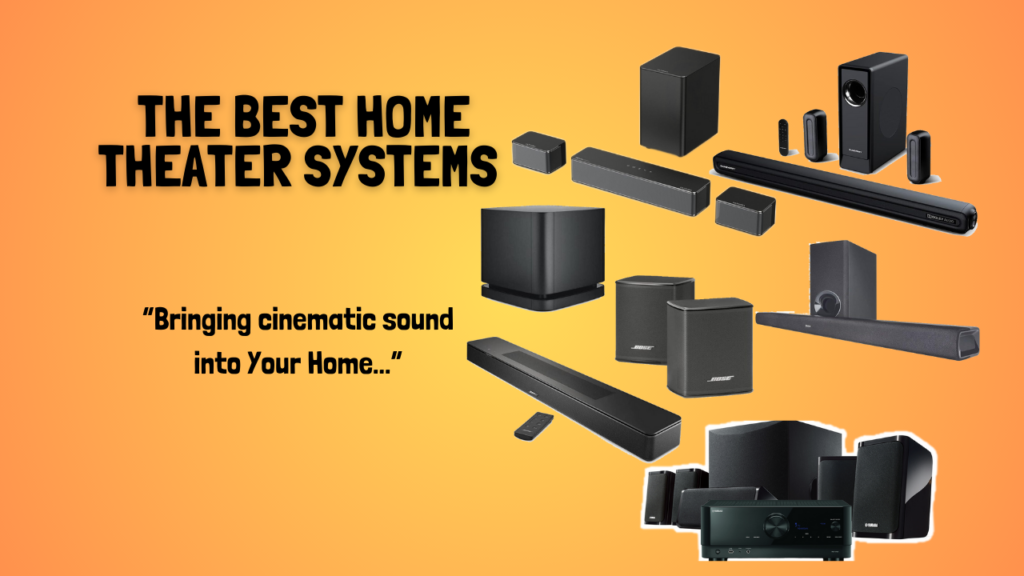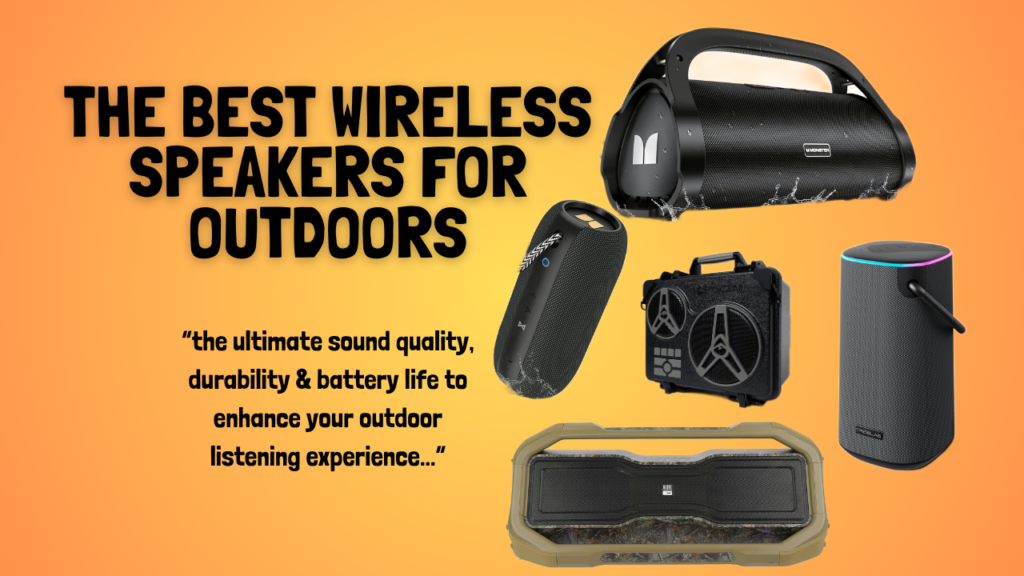I can’t begin to explain how keeping an external hard drive close by will greatly improve the quality of your digital life. If you have multiple computers at home, an external hard drive will allow you to transfer huge files quickly and easily between them. Not to mention, it can come in handy and all your important documents will be safely tucked in a backup drive just in case any one of your computers suddenly decides to act out. So if you’re looking to invest in an external hard drive, here are our top picks for the best external hard drives for 2021.
Affiliate Disclosure: I am grateful to be of service and to bring you content free of charge. In order to do this, please note that when you click links and purchase items, in most cases I receive referral commissions. Eventually, I may earn enough to buy a beer or two.
Importance Of An External Hard Drive
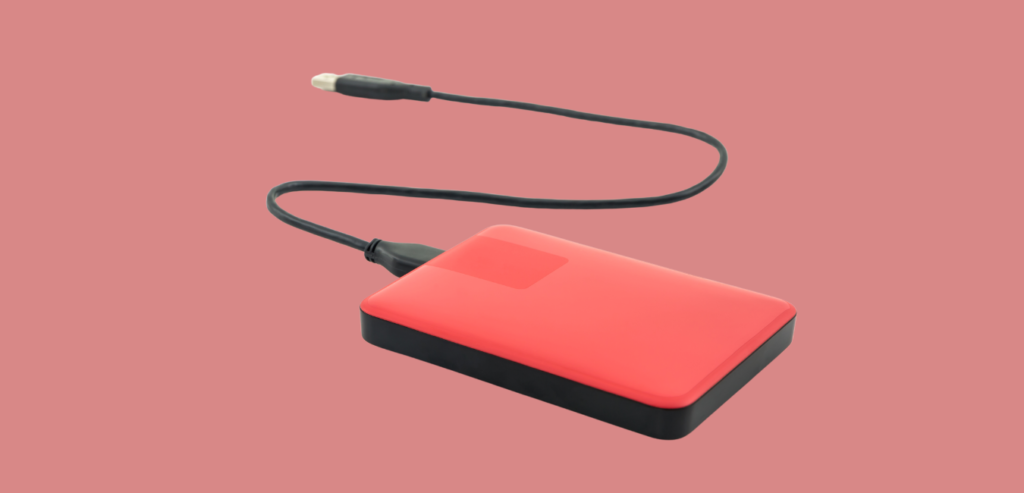
External hard drives come in a variety of shapes and sizes and are intended for a variety of applications. They all offer extra storage for backups and can be simply moved from one device to another. But apart from that, the list goes on endlessly when it comes to arguing why an external hard drive should be in everyone’s tech arsenal.
There’s almost nothing more frustrating than learning you don’t have enough space on your computer to save your most recent files. External hard drives can be a terrific answer to this problem, as well as a reliable backup source for your most important data.
While external hard drives may appear less necessary than they previously were now that we are in an era where 50GB of iCloud storage only costs 99 cents per month and slim external SSDs are becoming more affordable. However, the most recent external hard drives released are a lot quicker now, more stylish, modern, and more durable than their predecessors from a few years ago.
No more of those slow, bulky external drives of the past years. Almost every external hard drive today employs the USB 3.0 standard, which provides read and write speeds that are many times quicker than older USB 2.0 drives. Some also use the speedier USB 3.1 and 3.2 standards, while other certain models use the lightning-fast Thunderbolt 3.
External hard drives are also becoming bigger for the money. By just simply plugging in a USB cable to your machine, you can add a terabyte of extra storage to your laptop or desktop for just under $50.
Hard Drives Or SSDs?
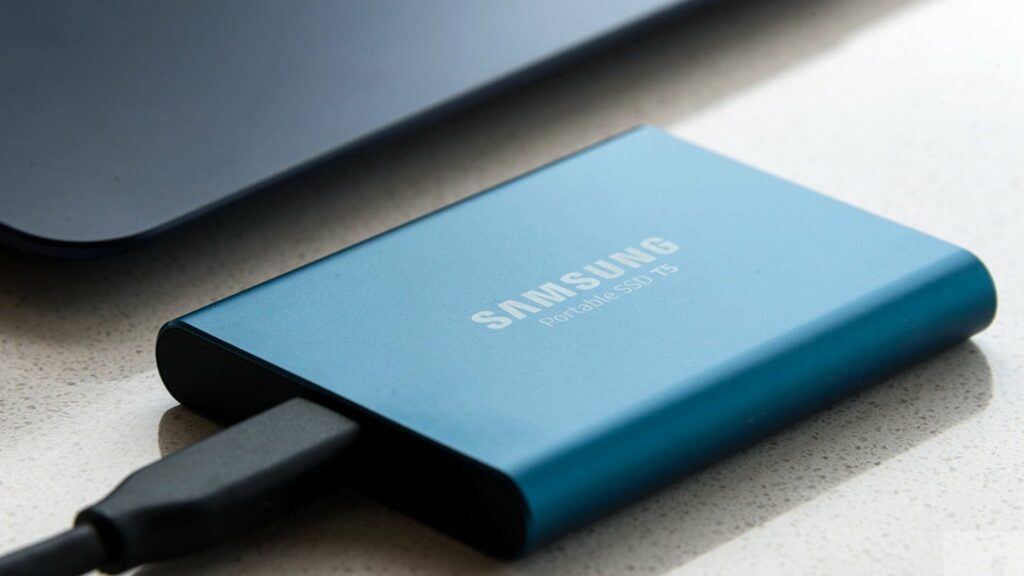
Hard drives will give you significantly more capacity for your money, but there is a significant difference in external storage in the market these days. You’ll have to decide whether you want a hard drive or the fastest option possible, the SSD.
One or more magnetically sensitive platters, an actuator arm with a read/write head for each platter, and a motor to spin the platters and move the arms make up a hard disk drive. There’s also an I/O controller and firmware that communicates with the rest of the system and informs the hardware what to do.
Each platter is divided into tracks, which look like formed concentric circles. These tracks are also separated into logical units called sectors. A unique address is generated for each track and sector number, which can be used to organize and locate data. The same data is written to the closest available storage location. Before the data is written, an algorithm processes it, allowing the firmware to detect and repair errors.
Meanwhile, SSDs, or solid-state drives, contain lesser moving parts than traditional hard drives and provide the fastest access to your data. In contrast to a traditional disk-based hard drive, which stores data on a spinning platter or platters accessed by a moving magnetic head, an SSD saves data using a group of flash cells similar to those found in a computer’s RAM.
However, because SSDs have so many microscopic, moving parts such as magnetic heads, spindles, and spinning platters, it’s also possible for something to go wrong and lead you to lose vital data.
How Fast Are These External Storages?
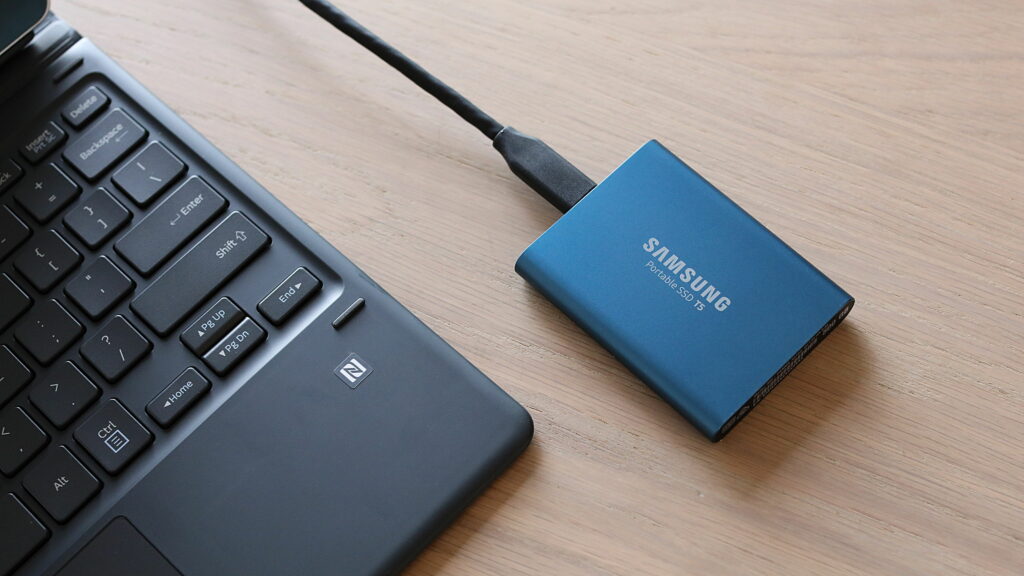
Consumer drives with spinning platters typically have read and write speeds of 100MBps to 200MBps, depending on platter density and whether they spin at 5,400rpm or 7,200rpm. External SSDs provide at least twice that performance, and in some cases significantly more depending on the model. In practice, this means you can transport terabytes of data from an external spinning disk to an external SSD in seconds rather than minutes.
Our Top Recommendations
1. Western Digital My Book Duo Desktop External Hard Drive

Overview
If you want to get your hands on the external hard drive with the largest storage capacity, the Western Digital My Book Duo is the one to choose. It has a whopping 3TB of storage space at minimum that’s spread between two hard drives, plus you can also opt to get similar variants that go up to 38TB of storage if you need that much extra space.
However, it’s also best to keep in mind that the My Book Duo is not the most portable drive out there. It would be a poor choice if you were looking for more compact external drives that you can take with you on the go. So this is definitely an external hard drive that is best used on top of a desk.
Nevertheless, its inherent performance boost over rival mechanical external drives, as well as Western Digital’s deliberate selections to balance performance, affordability, and reliability, make it the best external HDD in our opinion.
Not to mention, you can also set up RAID on the two drives inside this enclosure for file redundancy or speed, or use every bit of storage space. In any case, you’ll get a lot of storage capacity and a two-year warranty from a reputable manufacturer.
The Western Digital My Book Duo’s case is user-serviceable, which means you can replace defective drives yourself and use the enclosure long after the drives fail. On top of that, it also supports USB 3.1 for high-speed data transfer. With full support for 256-bit AES hardware encryption, you can be assured that no one but you will be able to read your data.
Check Out Our Full Review Of The WD My Book Duo Here.
Features & Specifications

- Dimensions: 6.3 x 3.94 x 7.09 inches
- Item Weight: 6.9 pounds
- Brand: Western Digital
- Storage Capacity: 3 TB up to 38 TB.
- Compatible Devices: Desktop
- Interface: USB 3.1 Gen 1 Ready, USB 3.0
Pros
- USB-C compatibility.
- Reliable 3-year warranty.
- Inclusion of a 2-port USB 3 hub.
- RAID 0 along with dual-drives for substantially faster performance than ordinary external drives.
Cons
- Not the most portable external drive.
- RAID 0 has no redundancy, so if one disk fails, you’re out of luck.
Rating: 9.5 out of 10.
Where Can I Buy The Western Digital My Book Duo Desktop External Hard Drive?
2. SanDisk Extreme Pro Portable SSD

Overview
The SanDisk Extreme Pro Portable SSD is a highly portable NVMe drive with reading speeds up to 1050MBps and is light enough to store and carry wherever you go. The Extreme Pro’s durable construction repels water and dust, and the silicon rubber covering and notch allows you to store it as you like.
Its rounded corners, black-and-red coloring, delicately pockmarked front, and soft-touch back give it a fully modern yet refreshingly vintage appearance and feel. Apart from that, we also like that the SanDisk Extreme Pro works with both USB-A and USB-C connections, so any concerns with device compatibility and about upgrading your devices to a USB-C connection in the future are thrown out the window.
While the 500GB storage option is the most cost-effective for people on the go, the disk may be upgraded to 2TB if desired.
The USB 3.1 version of the Extreme Pro Portable SSD is also one of the fastest drives in the market, delivering reading speeds of up to 1,050MBps. General encryption is also used by the SanDisk Secure Access application.
However, this particular drive is a little pricey for most people, and you might find the built-in carrying loop too large to fit on a typical keychain. But aside from that, this is a pretty amazing external hard drive for everyday use and one that is hard to beat in terms of portability.
Check Out Our Full Review of The SanDisk Extreme Pro Portable SSD Here.
Features & Specifications

- Dimensions: 0.41 x 2.28 x 4.36 inches
- Item Weight: 2.72 ounces
- Brand: Sandisk
- Storage Capacity: 500 GB up to 2 TB
- Compatible Devices: Laptop, Desktop
- Interface: USB Type C, USB 3.2 Gen 2×2
Pros
- Excellent balance between speed, functionality, and design.
- Encryption and backup features are included.
- Rugged, durable design.
- Portable.
Cons
- Expensive.
- Loop is too big for your average keychain use.
Rating: 9.5 out of 10.
Where Can I Buy The SanDisk Extreme Pro Portable SSD?
3. Samsung T5 Portable SSD
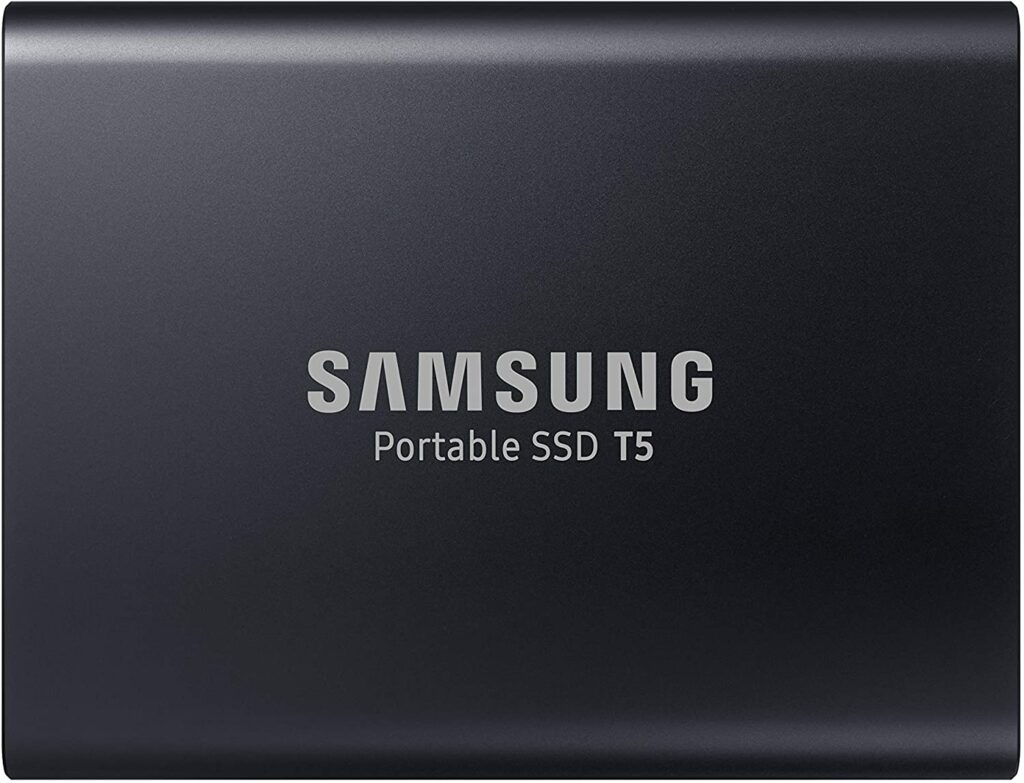
Overview
The Samsung T5 is a compact yet affordable high-speed storage drive that looks and feels like a top-tier portable storage solution. It uses Samsung’s latest 3D V-NAND technology to cram up to 2TB of storage space into a small form factor, though it comes in a variety of storage sizes and costs.
In various read and write tests, the solid-state drive outperformed its competition as well as its predecessor, the T3, while preserving the same physical footprint. Samsung also claims that this external drive, which is housed in a solid aluminum casing, can resist a drop from a height of up to 6 feet without any problems.
Although those are very big claims and I wouldn’t recommend putting such claims to the test, it’s critical that external drives, which aren’t shielded by the shell of a desktop or laptop, are durable enough to survive some abuse.
There is no other drive we can suggest as strongly as the Samsung T5 SSD because of its speed, compact size, portability, and additional features like suitable encryption software. When you go to the upper end of the storage space range, it can get a little expensive. A 2TB configuration will set you back several hundred dollars, but it’s a lot less expensive than it was a few years ago.
But if money is no object to you, this is definitely an external drive worth considering.
Features & Specifications

- Dimensions: 0.41 x 2.91 x 2.26 inches
- Item Weight: 1.8 ounces
- Brand: Samsung
- Storage Capacity: 250 GB up to 2 TB.
- Compatible Devices: Desktops, Laptops, Smartphones
- Interface: USB 3.1 Gen2 backwards comp.
Pros
- One of the fastest external hard drives in the market.
- Compact and portable.
- Sleek design.
Cons
- It’s on the more expensive side of external hard drives.
Rating: 9 out of 10.
Where Can I Buy The Samsung T5 Portable SSD?
4. Seagate Backup Plus Desktop Drive

Overview
If you want to have the best of both worlds, the Seagate Backup Plus Desktop Drive is one of the best options you can find in the market. It’s available in storage capacities up to 8TB and easily outperforms the competition in terms of reading and writing speeds.
If that’s not convincing enough, aside from the terrific storage and speed, Seagate’s lower-than-average failure rates, particularly in larger capacity hard drives, might urge you towards this excellent external hard drive a little bit more.
This particular drive comes with backup software and is compatible with both Windows and Macs, albeit it’s formatted for Windows out of the box unless you upgrade to a Mac-specific hard drive, which you might find a tad more expensive.
Not to mention, the device also includes Seagate’s own optional Dashboard application, which allows you to back up your smartphone’s material through a free app, as well as your social media from Facebook, Flickr, YouTube, Tumblr, and even cloud-based stuff such as Dropbox, Google Drive, or OneDrive, to the drive.
It also offers two backup options: one that is planned and one that is continuous. Value-added apps are typically fairly basic, and Seagate’s Dashboard is no exception. It only provides the bare minimum, allowing the customer to opt for more elaborate solutions if they so desire.
Features & Specifications

- Dimensions: 4.54 x 3.15 x 0.82 inches
- Item Weight: 7 ounces
- Brand: Seagate
- Storage Capacity: 4 TB up to 5 TB
- Compatible Devices: Desktops, Laptops
- Interface: USB 2.0 and 3.0
Pros
- Affordable.
- Lots of color options to choose from.
- Fast and reliable write and read speeds.
Cons
- Additional costs if you want a Mac-formatted version.
Rating: 9 out of 10.
Where Can I Buy The Seagate Backup Plus Desktop Drive?
5. LaCie Rugged Boss SSD
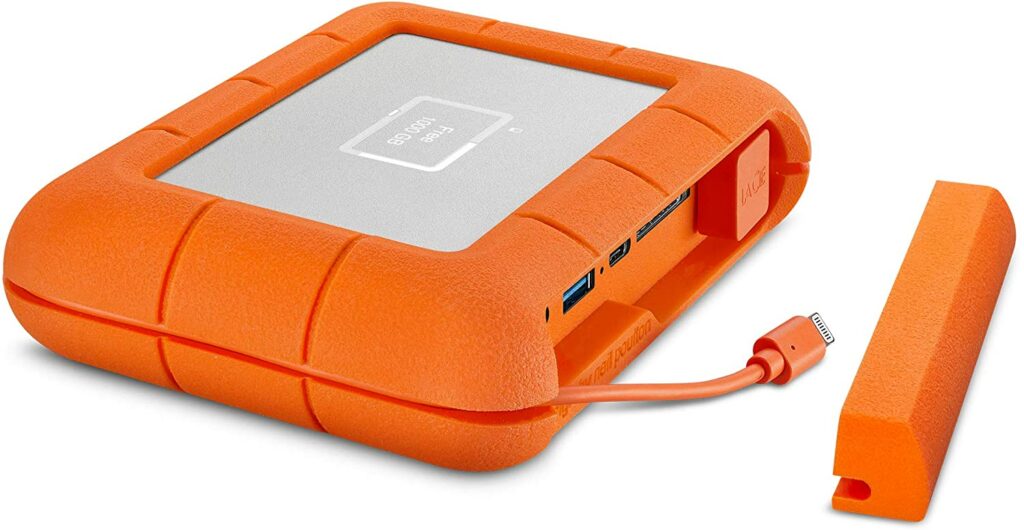
Overview
If you’re a photographer, a videographer, a filmmaker, or anyone who constantly works outdoors, you might want a rugged yet fast external drive to keep up with your workload. The LaCie Boss drive was designed specifically for these uses, featuring shock resistance, water splash resistance, and dust resistance capabilities.
But that’s only the start of what the LaCie Rugged Boss SSD has to offer. Apart from its terrific durability, it also has an SD card port, which is ideal for photographers who want to move their images to a larger storage device to free up space, as well as a useful status screen that shows transfer progress, current capacity, and current battery life.
On top of that, this battery may also be used to charge cameras, drones, and other devices that are running low on power. So if your power bank acts out, you can also opt to use this one to power up your devices.
While the capacity of the Boss drive may be adjusted between 500GB and 5TB, we found that 1TB was a fair compromise between the model’s already exorbitantly high price and its more than enough storage space to be practical. Simply ensure that all of your devices are USB-C compatible, and keep in mind that Thunderbolt 3 LaCie drives can also serve a similar role.
Features & Specifications

- Dimensions: 1.42 x 4.33 x 5.35 inches
- Item Weight: 6.4 ounces
- Brand: LaCie
- Storage Capacity: 500 GB up to 5 TB.
- Compatible Devices: Cameras, Laptops, Desktops
- Interface: USB, USB 3.0, USB Type C
Pros
- Portable.
- Rugged design makes it durable enough to survive the outdoors.
- Ideal for photographers, filmmakers, drone pilots, or anyone regularly working in the outdoors.
- Can also be used as a pseudo powerbank.
Cons
- Really pricey.
Rating: 8.5 out of 10
Where Can I Buy The LaCie Rugged Boss SSD?
6. Buffalo MiniStation Extreme NFC External Hard Drive
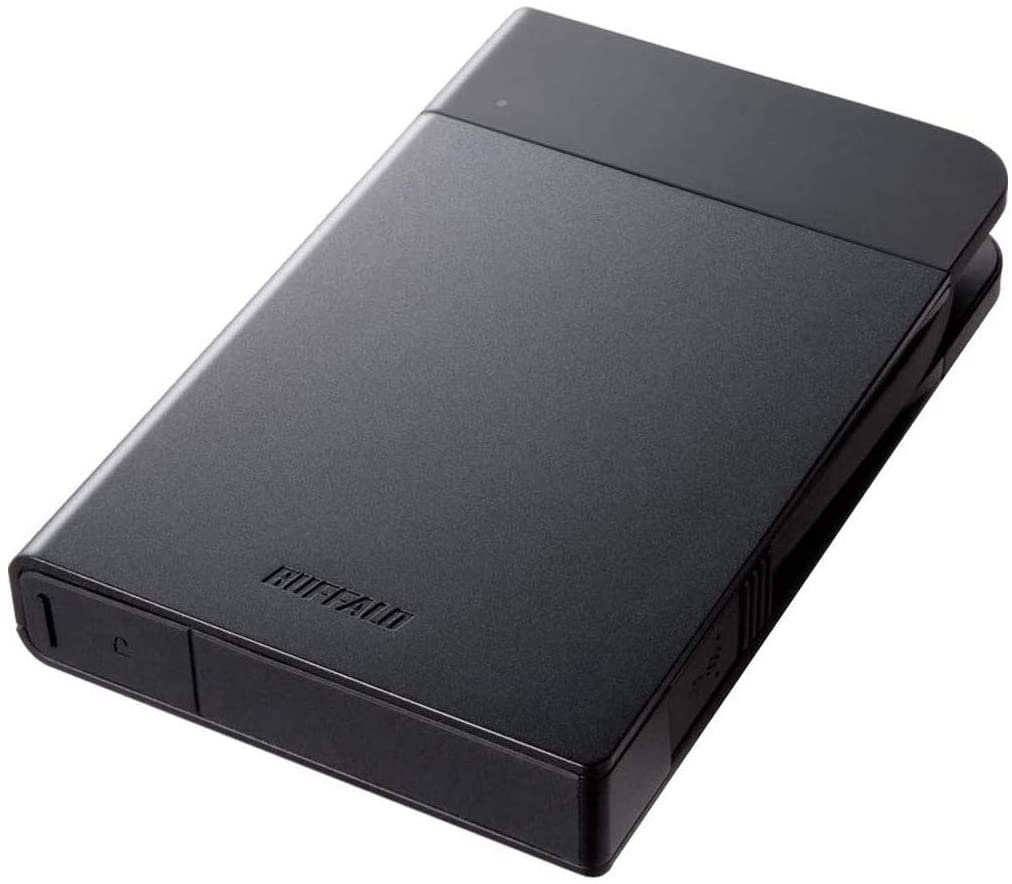
Overview
Buffalo‘s MiniStation Extreme NFC might just be perfect for you if you’re looking for the greatest external hard drive that will save you a ton of money. The Buffalo MiniStation Extreme NFC is a versatile device that works with both Mac and Windows devices and comes with a dust- and water-resistant shell as well as a built-in USB 3.0 connection.
The tough casing not only protects your data from bumps and drops but also includes 256-bit AES security and NFC (Near Field Communication) capabilities. Simply tap the included NFC card into the drive’s body to unlock the drive and gain access to your files quickly and easily.
Features & Specifications
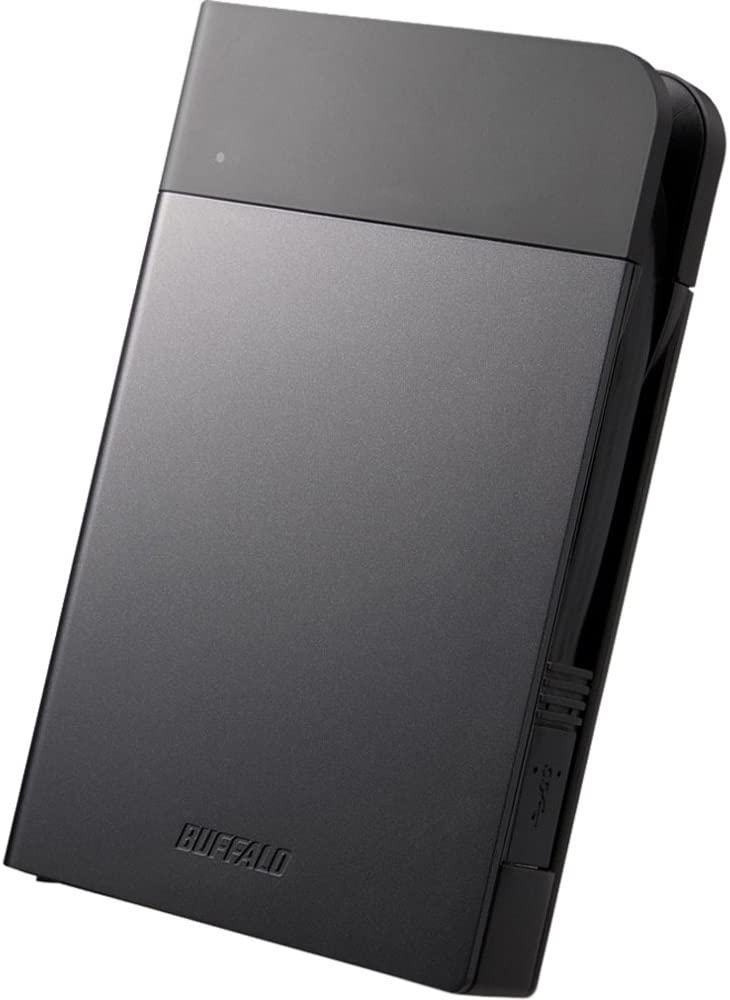
- Dimensions: 2.99 x 4.53 x 0.76 inches
- Item Weight: 10.6 ounces
- Brand: Buffalo
- Storage Capacity: 1 TB up to 2 TB
- Compatible Devices: Laptops, PC, Mac
- Interface: USB 3.0, USB 3.0
Pros
- Affordable.
- Rugged, durable design.
- Has NFC Security.
Cons
- A little sluggish.
Rating: 8 out of 10.
Where Can I Buy The Buffalo MiniStation Extreme NFC External Hard Drive?
Before You Buy

Now that we have discussed our top picks for the best external drives for 2021, it’s best to keep in mind that selecting an external drive is more complicated than simply purchasing the most expensive model available. There are a lot of important factors that go into it deciding which external hard drive is best for you.
The most crucial element to consider is the drive capacity, which can substantially increase or decrease the cost based on your needs. Other considerations include the drive’s physical size, its durability, design, the interface it utilizes to connect to your PC, and even the colors it comes in. The guide below seeks to help you out on these aspects.
Storage Capacity
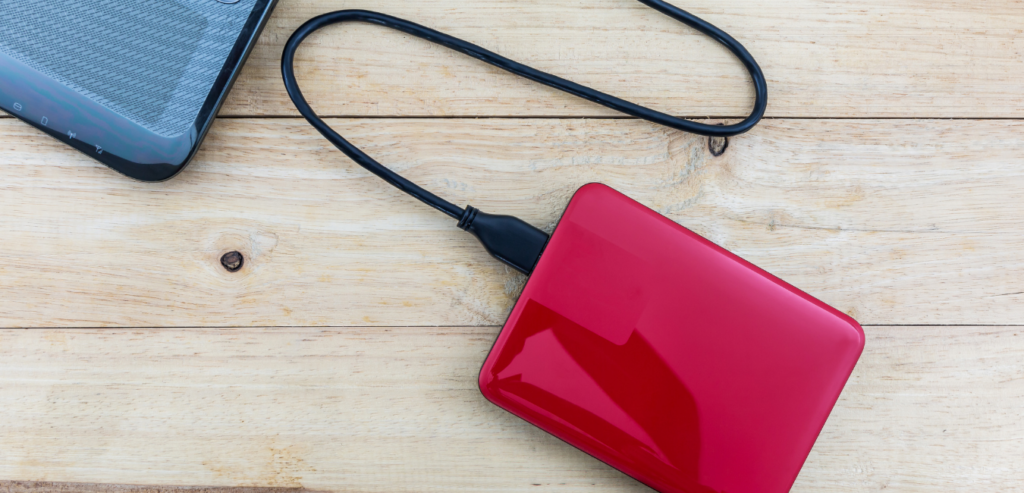
Storage space is arguably the most important feature to consider when purchasing an external hard drive. It’s pointless to invest in a high-speed device with all the modern and advanced features such as encryption and remote access if it can’t save all your data. At the same time, you also don’t want to overpay for a drive that you won’t even come close to filling. The last thing we want is to waste money, right?
So what exactly is the ideal storage space for an external hard drive? Well, that is completely all up to you and whatever you’re planning to store in your external hard drive.
A mid-range external hard drive may be perfect for you if you just need to move papers, images, or other pieces of documents from one device to another for the most part, or just wish to enhance the storage space of your low-end laptop or any other device like your tablets or smartphones.
While the greatest of these mid-range external hard drives may hold up to 2TB of data, they can be quite expensive and unnecessary for basic transfers like the ones stated previously.
Instead, I would highly suggest saving your money and purchasing an external hard drive with 500 GB to 1 TB of storage for no more than $50. For not much more, you can also acquire drives with twice the storage too along with good bundled deals.
On the other hand, you’ll need something more substantial if you wish to store a lot more data or keep files and folders for a longer period of time. If this is the case, starting with a 1TB external drive should be enough for most of you unless you’re planning to save your entire movie collection as well as your favorite TV shows.
Size

External hard drives are usually meant to be extremely portable or primarily stationary but it also comes in different shapes and sizes. As a general rule, desktop drives are better for offices or staying on your desk where the majority of the work is done in the same space. This type of external hard drive is mostly used as extra storage that is rarely removed from the workstation.
Additionally, desktop drives are ideal for you if you have a massive media file collection. If you’re a photographer, an editor, or just a huge movie buff like me, you’ll certainly require many terabytes of storage space so you don’t run out of it easily.
You might also see bigger-sized desktop drives every now and then in the market too. These larger models are more expensive, but they can hold a lot more data, up to 16TB or even more. Some are so large that they’ll need to be stored under your desk or in a separate server closet. They’re primarily designed for professional use such as editing studios, surveillance control rooms, and similar environments.
Portable drives, on the other hand, are more self-explanatory. They’re smaller, often designed ruggedly, and meant to fit into pockets or cases for people on the go. This is quite perfect for you if you’re someone who moves around a lot.
If you’re a business traveler, photographer, or even a filmmaker, and basically anyone else who manages large files using computers, cameras, smartphones, and other mobile devices as you travel, you will certainly appreciate this type of external hard drive. The rugged design also helps in keeping the external drive durable and safe from accidental drops or water splashes.
Speed
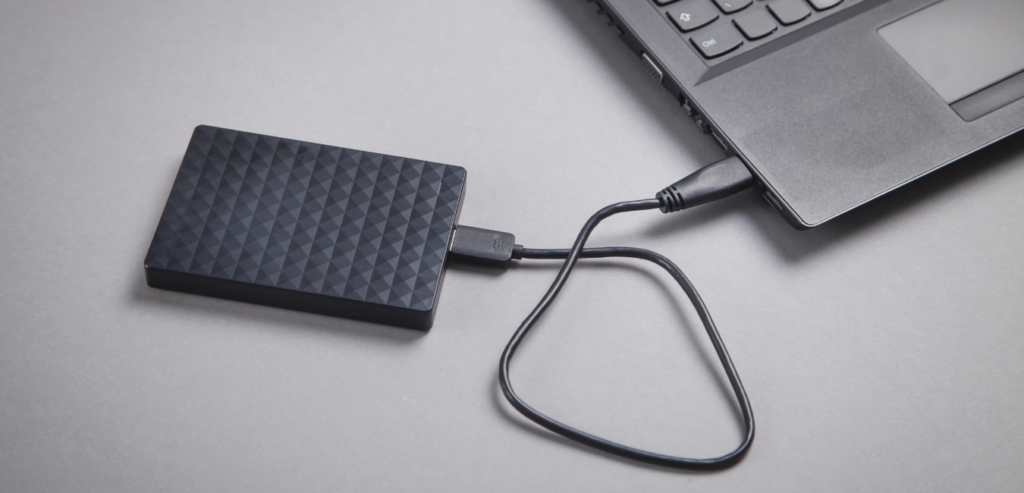
When it comes to picking an external drive, the speed with which data is transferred is critical. You don’t want to wait for an eternity for a single file transfer to be completed if you move data back and forth on a frequent basis.
With that in mind, the underlying storage technology and the connector your drive utilizes both play an impact on how fast it can perform as you transfer files. Although certain drives are quicker than others, SSDs can process data more quickly than HDDs in general.
However, external SSDs are often more expensive than external HDDs and have less storage capacity. You don’t need one or the other because SSDs with larger storage capacities are available for a higher price. It’s all up to you which compromises you’re willing to take.
When it comes to connectors, there are various typical alternatives to choose when it comes to connecting your external drive to your PC, laptop, or mobile device. Although most drives now feature a USB interface, the most recent generations have several notable distinctions, particularly in terms of transfer speed.
Interface
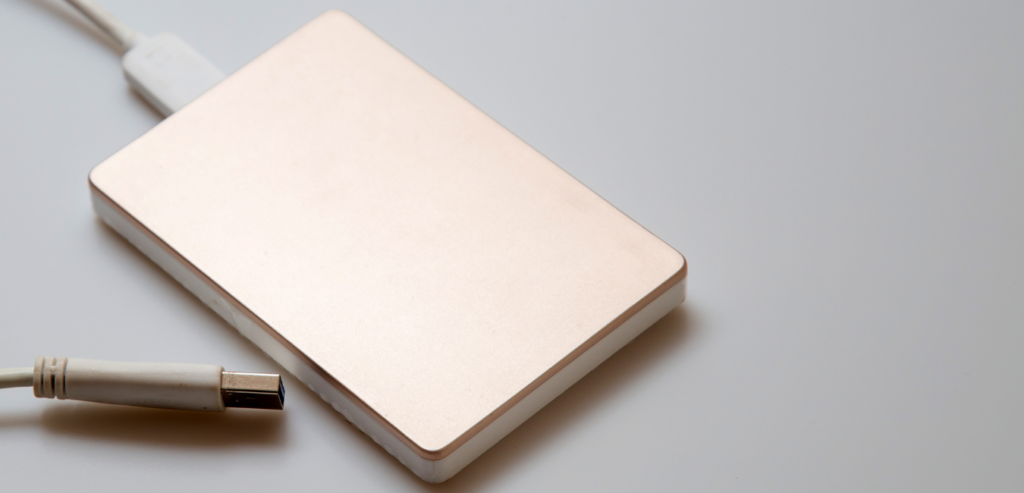
The sort of storage mechanism used by an external drive is second only to how it connects to your PC or Mac in determining how quickly you can retrieve data. These connection types are always changing, although most external hard drives now use USB or, in rare circumstances, Thunderbolt. Below are some examples of these connection types.
Avoid USB 2.0 at all costs, as its maximum transfer speed is only 480Mbps and this type of interface is quite outdated already. On most PCs, the port is not color-coded. Beyond USB 2.0, things can become a little tricky or confusing.
USB 3.0, USB 3.1 Gen1, and USB 3.2 Gen1 are examples of these specifications. However, all three are virtually identical, with speeds of up to 5Gbps and a blue color-coding. Meanwhile, USB 3.1 Gen2 and USB 3.2 Gen2 are identical, with red color coding and 10Gbps transfer speeds.
The fastest of the bunch would be USB 3.2, or 3.2 2×2, which offers up to 20Gbps. USB-C is a reversible connector that is newer, smaller, and more rounded. The DisplayPort protocol for video output is tethered to this port as well. Some connectors include USB-C ports but employ the Thunderbolt 3 protocol, which can carry data at up to 40 Gbps.
With that being said, a Thunderbolt 3 connection is what you should aim for. If it’s too pricey, you can just go down the line but never farther than USB 3.1.
Conclusion
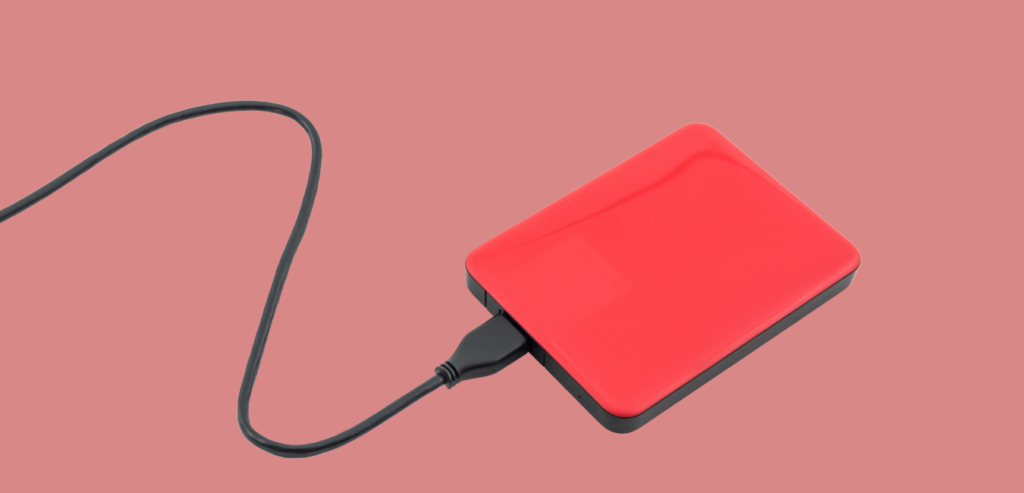
Now that we have reached the last part of our article, I hope you were able to find an external hard drive suitable for you in our top picks. Overall, the best hard drive depends on the person using it. What might be good for you, might not be the same for other people. However, it’s best to choose a drive that has a great balance between speed, form factor, and other functionalities such as security and future-ready interfaces.
Have you already bought your own external hard drive? Did your pick make it into our list? Let me know in the comments section below if you have any suggestions to share, insights, or questions to ask. I would love to hear all your thoughts!
Recommended reading for you:
- WD My Book Duo Review: The Best External Hard Drive?
- LG OLED C1 Review: The Best 4K TV For Gaming?
- Samsung QN90A Review: Better Than OLED TVs?
- Best Android Tablets For Gaming In 2021: Our Top Picks
- Apple iPad 8th Gen Review: A Great Value, Kid-Friendly Tablet
- Android Tablets Buying Guide 2021: What You Need To Consider
- Samsung Galaxy Tab S7 Plus Review: The Best Android Tablet?
- The Best Headphones For Gaming In 2021
- Best 4k Gaming Monitors 2021: The Sharpest & Brightest Displays
- The Asus ROG Strix XG27UQ Review: Immerse Yourself In The Latest AAA Games With The Best 4k Gaming Monitor
- The LG 27GN950-B Review: Watch Your Games Come Alive On 4k
- How To Buy The Best 4k Gaming Monitors 2021
- Best Gaming Desks 2021: Reign Supreme In Comfort & Style
- Your Quick Guide To Buying PC Gaming Desks 2021
- Best Computer Gaming Chairs For Adults 2021: For Next Level Gaming!
- SanDisk Extreme Pro Portable SSD Review: Excellent Speed & Portability
- External Hard Drive Buying Guide 2021: What You Need To Know
- 4K TV Buying Guide For Gaming: Bigger Displays & Better Response Time
- The Best Tablets For Kids In 2021: Parent-Approved & Kid-Friendly!
- How To Choose The Best Tablet For Your Kids 2021
- The Amazon Fire HD 10 Kids Pro Review: A 2021 Review On The Best Tablet For Your Child
- SteelSeries Arctis Pro Review: The Best Gaming Headset For Audiophiles
- Razer BlackShark V2 Pro Review: The Best Wireless Gaming Headset?
- Best Computer Gaming Chairs For Adults 2021: For Next Level Gaming!
- Cougar Argo Gaming Chair Review: Is It The Next Best Thing?
- The Cougar Mars 120 Gaming Desk Review: Your Superior Gaming Desk With LED Lights
- The Arozzi Arena Gaming Desk Review: Go Big Or Go Home With Your Gaming Setup












